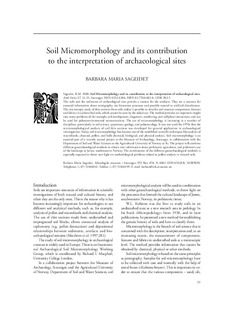| dc.description.abstract | The soils and the sediments of archaeological sites provide a context for the artefacts. They are a resource for
essential information about stratigraphy, site formation processes and possible natural or artificial disturbances.
The microscopic study of thin sections from soils makes it possible to describe and measure components, features
and fabrics in undisturbed soils, which cannot be seen by the naked eye. The method provides an important insight
into many problems of, for example, soil development, diagenesis, weathering, and soil/plant interactions, and can
be used for palaeoenvironmental reconstructions. The use of micromorphology is increasing in a number of
disciplines, particularly in soil science, quaternary geology, and palaeoecology. It was not until the 1970s that the
micromorphological analysis of soil thin sections was developed for general application in archaeological
investigations. Today, soil micromorphology has become one of the established scientific techniques like analysis of
macrofossils, charcoal, pollen, and bulk chemical, biological, and physical analysis. Soil micromorphology is an
essential part of a recently started project at the Museum of Archaeology, Stavanger, in collaboration with the
Department of Soil and Water Sciences at the Agricultural University of Norway at Ås. The project will combine
different geoarchaeological methods to obtain new information about prehistoric agriculture, and prehistoric use
of the landscape at Jæren, southwestern Norway. The combination of the different geoarchaeological methods is
especially expected to throw new light on methodological problems related to pollen analysis in mineral soils. | no_NO |
